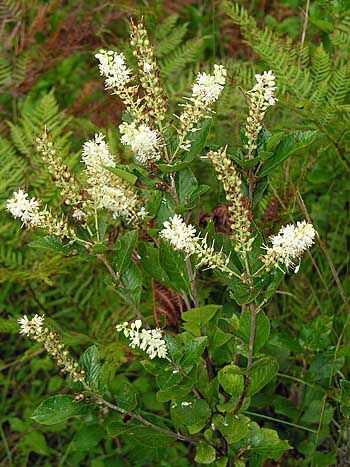Clethra is a superb shrub that has a lot going for it.
It has attractive bottle-brush shaped blossoms, it can tolerate shade or sun, it likes moist soils, it attracts butterflies, it is native to Maine and it blooms in summer — July to September, depending on location and variety.
The most wonderful thing about it, though, is its fragrance. When it is in bloom, you can smell the plant from 50 feet or more away. It is intoxicating. One of its common names is summersweet, which alludes to the fragrance, and another is pepperbush.
Clethra also has one disadvantage, mentioned by all four nursery professionals I contacted for this column. People not familiar with the species’ growth habits will go out into their garden on Memorial Day and be convinced that it is dead. The leaves don’t start appearing until June in some years.
All four nurseries interviewed for this column sell Clethra alnifolia, both as the native species and its cultivars. O’Donal’s Nursery in Gorham also sells two non-native clethra (more details later). But we start with Clethra alnifolia.
“I like clethra,” said Deb Bedard of Springvale Nurseries, “because the blossoms are an upright columnar shape rather than round. So many flowers are round, and it is nice to have a different size and shape.”
“As a native,” said Tim Bate of Skillins in Falmouth, “Clethra fits into a woodland garden setting. It’s a perfect choice. And it is wonderful to have a flower in summertime that isn’t a hydrangea.”
“They have a fairly short bloom time,” said Tom Estabrook of Estabrook’s in Yarmouth, Scarborough and Kennebunk, “but it has a nice seed head that it keeps into the fall, and the foliage has a brilliant orange-yellow color.”
“They sucker up well,” said O’Donal, “so they do a good job of stopping erosion into a pond.”
Bedard said she wouldn’t want to plant a mass of clethras because they leaf out so late, you would have a mass of brown twigs well into May — and that look wouldn’t please most gardeners.
And while the general rule for clethras is moist soil and part shade, Bedard and O’Donal said they will do well in sandy soil or full sun, but you will have to water them more in those locations. Clethras also will grow in full shade, but won’t be as full and might require more pruning.
When it comes to full-size white and pink clethra, the four professionals agreed.
“Ruby Spice,” a Cary Award winner in 2000, is the choice for pink. It grows 5 to 6 feet tall, will spread well, and is hardy.
All of the other clethras that say they are pink start out with a pink bud but fade out to white as they fill out. But “Ruby Spice” will keep its dark-pink color throughout the season.
If you want a full-size white clethra, 8 to 10 feet tall, you will do best with the seedling or species plant. It is hardy to Zone 3, is superbly fragrant, and is an outstanding plant.
But when you get to the compact white cultivars — 3 to 4 feet tall — there is a bit of disagreement.
Estabrook prefers “Hummingbird,” which is one of the older compacts, a heavy bloomer that does well.
O’Donal likes “Sixteen Candles,” a recent introduction from Michael Dirr, because it has a darker green foliage that shows off the white blossoms better.
And Bate likes the new Proven Winners introduction “Vanilla Spice.” It is a bit larger, but has a fragrance all its own.
I forgot to ask Bedard, and we have grown none of the compacts in our garden, so check them out and make your own choice.
The non-native clethras available at O’Donal’s — Clethra acuminata or cinnamon clethra and Clethra barbinervis or Japanese clethra — are both larger than alnifolia while still being fragrant. Both have been growing for 10 years or more in front of the O’Donal’s nursery, even though the Japanese clethra is a Zone 5 plant, somewhat of a stretch for Gorham. Both have white flowers.
“They both sucker like alnifolia, but they can be grown as a large shrub or a tree,” O’Donal said.
The cinnamon clethra’s bark peels to show an underlying cinnamon bark, and it has very large flowers that hang like those on an andromeda.
While most clethra prefer moist soils, this one prefers dry, sandy soil. It can grow to 10 feet tall.
The Japanese clethra has hanging flowers that grow 9 to 10 inches long on a shrub or tree that can grow 10 feet tall.
“Its bark peels, sort of like a Stewartia, showing different patches of color on it,” O’Donal said. “And the fall color has leaves of yellow, orange, pink to maroon, all on one plant. It’s spectacular.”
Tom Atwell can be contacted at 791-6362 or at:
tatwell@pressherald.com
Send questions/comments to the editors.



Success. Please wait for the page to reload. If the page does not reload within 5 seconds, please refresh the page.
Enter your email and password to access comments.
Hi, to comment on stories you must . This profile is in addition to your subscription and website login.
Already have a commenting profile? .
Invalid username/password.
Please check your email to confirm and complete your registration.
Only subscribers are eligible to post comments. Please subscribe or login first for digital access. Here’s why.
Use the form below to reset your password. When you've submitted your account email, we will send an email with a reset code.